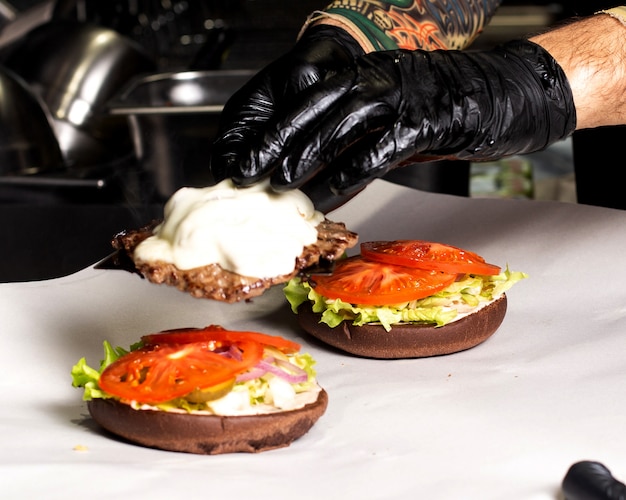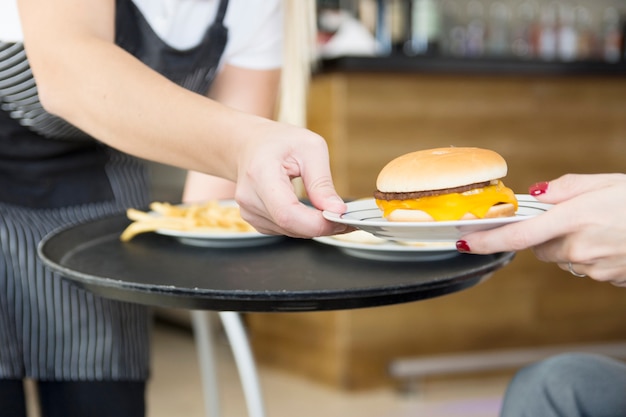You know that feeling: the aroma of sizzling burgers filling the air, the anticipation building with every juicy sizzle. Ah, there's nothing quite like a perfectly cooked burger, and for me, the George Foreman Grill is the ultimate tool for achieving that golden-brown, flavorful masterpiece. It's my trusty companion in the kitchen, always ready to deliver delicious results. But let's be honest, even the simplest of grilling tasks can feel like a culinary mystery sometimes, especially when it comes to mastering those cooking times. So, grab your spatula and get ready to dive into the world of George Foreman Grill hamburger cooking times – we're about to embark on a journey to perfect your patty game.
(Part 1) The Basics of George Foreman Grill Cooking

Before we get into the nitty-gritty of cooking times, let's lay down some fundamental groundwork. You know how people say, "It's not the tool, it's the craftsman?" Well, with the George Foreman Grill, it's all about understanding its quirks and features to make the most of its capabilities. Here's the inside scoop on what I've learned over years of grill-induced joy.
The Importance of Preheating: Your Patty's First Impression
Listen up, because this is a crucial step: preheating. I used to think it was just a fancy term, but trust me, it's essential! Preheating ensures that the grill reaches the right temperature for even cooking and a delicious sear, preventing those raw patches that nobody wants. Think of it like setting the stage for your burger's grand entrance. You wouldn't serve a dish without warming the plate, would you? Same goes for your grill.
The Power of the Grill's Tilt: The Fat-Fighting Hero
Here's a little secret: most George Foreman Grills have a tilt. It's not just for aesthetics – it's a clever design feature that helps drain excess fat away. Why is this important? It results in a healthier, less greasy burger, making it easier to enjoy that delicious flavour without the guilt. And let's be real, who doesn't appreciate a little grease-free goodness? Plus, it makes cleaning a breeze, which is always a bonus in my book.
The Art of Fat Reduction: Creating a Lean, Mean Burger Machine
We all know that burgers are all about that juicy, savory goodness, but nobody wants a patty swimming in a pool of grease. That's where the George Foreman Grill's unique design shines. Those grooves are like little fat drains, allowing those unwanted juices to escape while still locking in that delicious burger flavor. It's a win-win – you get a healthier patty without sacrificing taste.
(Part 2) Navigating the World of Burger Thickness

Now, let's talk about a crucial factor that affects cooking time: the thickness of your burger. Each patty has its own unique personality when it comes to grilling. Let's explore the different types and how to navigate their cooking demands.
The Thin Patty: A Speedy Culinary Sprint
Think of the thin patty as the sprinter of the burger world. It's about 1/4 inch thick, which translates to a fast cooking time. These guys are ready to go in a flash, typically requiring only 3-5 minutes on the grill. Keep an eye on them, and you'll know when they're perfectly cooked and ready to be devoured.
The Classic 1/2 Inch: The Goldilocks of Burger Thickness
Now, we're talking about the classic 1/2 inch patty. It's my personal favourite because it strikes the perfect balance between meaty and manageable. For a juicy medium-rare to medium doneness, I usually cook these for 6-8 minutes. If you prefer well-done, add another 2-3 minutes to the grilling time. It's like a culinary sweet spot, not too thin, not too thick – just right.
The Thick and Juicy: The Gourmet Burger Experience
For those who crave a truly indulgent burger experience, the thick patty is your calling. We're talking about 1 inch or more of deliciousness. Be prepared to invest a little more time – around 8-10 minutes for a medium-rare to medium doneness, and up to 12 minutes for well-done. Just remember, the thicker the patty, the more important it is to keep an eye on the internal temperature to ensure it's cooked to perfection.
(Part 3) Mastering the Art of Doneness: The Burger's Inner Journey

Ah, the elusive art of doneness! Everyone has their own preference, from the rare aficionados to the well-done diehards. But the real question is: how do we know when that burger is truly cooked to our liking? Let's delve into the world of burger doneness indicators.
The Finger Test: A Time-Honored Tradition
I've been using the finger test for years, and it's a simple, reliable method. Just press gently on the centre of the patty. If it feels springy, like your finger is pressing on a muscle, it's rare. If it feels a bit firmer, it's medium-rare. And if it's very firm, you're in the realm of medium to well-done. It's not a perfect science, but it provides a good estimate.
The Temperature Check: The Scientific Approach
For those who prefer a more scientific approach, a meat thermometer is your trusty ally. For medium-rare, the internal temperature should be around 130°F (54°C), medium is around 140°F (60°C), and well-done is 160°F (71°C). It's a good idea to have a thermometer handy, especially when dealing with thicker patties, to ensure the burger is cooked through.
Visual Clues: The Burger's Colourful Story
Don't underestimate the power of visual cues! A rare burger will have a reddish-brown color, while a well-done burger will be more brown. As the burger cooks, you'll notice the juices start to rise, signifying its journey to deliciousness.
(Part 4) The Importance of Flipping: A Dance of Culinary Precision
Now, some people swear by one-sided grilling, but I'm a firm believer in the art of flipping. A good flip is essential for ensuring even cooking and preventing those flat, greasy burgers. It's all about timing and technique, and here's how I do it:
First Flip: Early and Gentle
The first flip should happen early in the game. I usually flip after about 3-4 minutes, depending on the thickness of the patty. Be gentle! You don't want to break the burger apart. Let it get a nice sear on the first side before flipping it over to allow for even cooking.
Second Flip: When It's Time
The second flip depends on your desired level of doneness. If you're aiming for a juicy medium-rare, you might flip again after another 3 minutes. For well-done, you'll need to leave it a little longer. The key is to flip when you think the bottom side is cooked to your liking, allowing the top side to cook evenly as well.
The Final Flip: A Finishing Touch
The final flip is all about that finishing touch. Once the patty is almost done, I give it a quick flip to ensure that both sides have a lovely crust. This is a bit of a personal preference, but it adds that extra layer of flavor that takes your burger to the next level.
(Part 5) Adding Flavour to Your Burger: A Symphony of Taste
Now, let's talk about the real star of the show: flavor. It's not just about cooking time; it's about creating a burger that's bursting with deliciousness. Get ready to unleash your inner culinary artist.
Seasoning is King: A Simple, Powerful Move
Firstly, let's address the basics: seasoning. Don't be shy with the salt and pepper! I like to season both sides of the burger generously before grilling. It's a simple step that elevates the flavor profile. If you're feeling adventurous, you can add a touch of garlic powder or onion powder to add another dimension to your patty's aroma.
The Power of Marinades: Infusing Flavor from Within
For those who crave an extra layer of flavor, a marinade can work wonders. I often use a simple marinade of olive oil, lemon juice, and herbs, letting the patties soak for at least 30 minutes before grilling. You'll be amazed at how much this simple technique enhances the flavor of the burger. It's like giving your patty a luxurious spa treatment before its grand grilling debut.
Topping It Off: The Ultimate Customization
Finally, we arrive at the crowning glory: toppings! This is where you get to unleash your creativity. I'm a big fan of classic toppings like lettuce, tomato, onion, and pickles, but don't be afraid to experiment. Try adding grilled pineapple, avocado, or even a fried egg for a truly unique burger experience. The sky's the limit!
(Part 6) The George Foreman Grill: A Versatile Kitchen Hero
Hold on, because we're not just talking burgers here. The George Foreman Grill is a true kitchen hero, capable of handling a wide range of culinary tasks. It's like a multi-talented chef in your kitchen, ready to tackle everything from chicken and fish to vegetables and sandwiches.
grilling chicken: A Quick and Easy Feast
I often use my grill for chicken breast or chicken thighs. They cook quickly and evenly, and the grill marks add a lovely touch. For chicken breast, I usually cook them for about 6-8 minutes per side, depending on the thickness. Chicken thighs require a slightly longer cooking time, around 8-10 minutes per side.
Fish on the Grill: A Delicious, Healthy Option
Fish fillets are another great option for the George Foreman Grill. I love grilling salmon and cod – they cook up beautifully in about 5-7 minutes per side. Just make sure you use a grill-safe spatula to flip them gently and prevent them from breaking apart.
Veggies, Veggies, Veggies: A Rainbow of Flavors
Don't forget about vegetables! The George Foreman Grill is fantastic for grilling vegetables like bell peppers, zucchini, and eggplant. Slice them thinly and cook for about 5-7 minutes per side. You can even use the grill to cook corn on the cob. Just remove the husks and silks and grill for about 10-12 minutes, rotating it every few minutes to ensure even cooking.
(Part 7) Troubleshooting Your George Foreman Grill: When Things Go Awry
Let's face it, no kitchen appliance is perfect. There might be times when your George Foreman Grill throws you a curveball. But don't panic! Here are a few common problems and how to troubleshoot them.
The Burger is Sticking: A Grilling Dilemma
This is a common problem, especially if you're not using enough grease. If your burgers are sticking to the grill, try greasing it before you cook. You can use a bit of olive oil or cooking spray. Another trick is to let the grill preheat for a bit longer. Sometimes, a hotter grill surface will prevent sticking.
Uneven Cooking: A Culinary Balancing Act
If your burgers are cooking unevenly, you might need to adjust the cooking time. You can also try flipping them more frequently to ensure that both sides get cooked evenly. Make sure you're not overcrowding the grill, as this can also lead to uneven cooking.
The Grill Isn't Heating Up: A Power Play
If your George Foreman Grill isn't heating up, check the power cord and make sure it's plugged in properly. You can also try resetting the grill by unplugging it and then plugging it back in. If that doesn't work, you might need to contact the manufacturer.
(Part 8) Cleaning Tips for Your George Foreman Grill: Keeping it Pristine
Cleaning your George Foreman Grill is essential for keeping it in tip-top shape and ensuring that your future burger adventures are grease-free and flavorful. Here are my go-to tips for keeping it sparkling clean:
The Quick Wipe Down: A Post-Grilling Ritual
After each use, I give the grill plates a quick wipe down with a damp cloth. This helps remove any leftover food particles and prevents them from sticking, making your next grilling session a breeze.
The Deeper Clean: A Thorough Refreshment
For a deeper clean, I use a non-abrasive cleaner and a soft sponge. I avoid using harsh cleaners or scrubbing pads, as they can damage the grill plates.
The Degreasing Process: Removing Stubborn Grease
If you've been grilling some particularly greasy burgers, you might need to degrease the grill. I use a mixture of baking soda and water. I sprinkle the baking soda over the grill plates, then add a little water to make a paste. I let it sit for a few minutes, then scrub it with a soft sponge. Finally, I rinse it off with water and wipe it dry.
(Part 9) FAQs: Answering Your Burning Questions
Let's address some common questions about George Foreman Grills and burgers, because a well-informed grill master is a happy grill master.
Why are my burgers flat and greasy?
This usually happens when you overcrowd the grill. Give those burgers some space to breathe, and they'll cook more evenly, resulting in a beautifully browned and juicy patty.
How do I get those perfect grill marks?
A hot grill is your best friend! Make sure the grill is preheated before you add the burgers. And don't forget to flip them gently, giving them a good sear on both sides. This will create those iconic, aesthetically pleasing grill marks.
How long should I let my burger rest after grilling?
Let those juices redistribute! Resting the burger for 5-10 minutes before slicing will prevent all the delicious juice from running out, ensuring a juicy and flavorful bite.
What if my burger is still raw in the middle?
This is a sign you need to cook it longer! Keep flipping it, and check the internal temperature with a meat thermometer to ensure it's cooked to your liking.
Is it okay to use frozen patties?
Absolutely! Just make sure you let them thaw completely before grilling. You can also use the frozen patties directly, but it will take a little longer to cook.
(Part 10) Conclusion: A culinary journey to Burger Bliss
And there you have it – my guide to perfect George Foreman grill burgers! It's all about finding the right balance of cooking time, doneness, and flavor. Remember, practice makes perfect, and you'll soon be grilling burgers like a pro.
So, get out there, fire up your George Foreman Grill, and let's get grilling! Happy burgering!
Everyone is watching

Prime Rib Roast Cooking Time Chart: Per Pound Guide
Cooking TipsPrime rib roast. Just the name conjures images of lavish dinners, crackling fires, and hearty laughter. It’s ...

How Long to Bake Potatoes in the Oven (Perfect Every Time)
Cooking TipsBaked potatoes are a staple in my kitchen. They're incredibly versatile, delicious, and surprisingly easy to m...

Perfect Rice Every Time: The Ultimate Guide to Cooking Rice
Cooking TipsAs a self-proclaimed foodie, I've always been a bit obsessed with rice. It's the foundation of countless cuisi...

The Ultimate Guide to Cooking Asparagus: Tips, Techniques, and Recipes
Cooking TipsAsparagus. The mere mention of this spring delicacy conjures up images of vibrant green spears, crisp and burs...

Ultimate Guide to Cooking the Perfect Thanksgiving Turkey
Cooking TipsThanksgiving. Just the word conjures up images of overflowing tables laden with delicious food, the scent of r...
